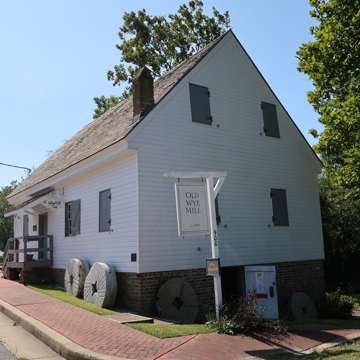This is the oldest frame gristmill on the Eastern Shore, if not in the state, reflecting an integral segment of the regional economy from the period of settlement into the twentieth century. Gristmills were first erected for local use, powered by wind or by the many rivers and streams along the Eastern Shore. As demand for wheat increased with the export trade during the late eighteenth century, so did gristmill construction. Wye Mill rests on the site of a c. 1671 mill erected by Edward Barrowclif that was owned for much of the eighteenth century by Edward Lloyd of Wye House.
The humble, one-and-a-half-story mill is of braced, heavy-timber frame construction covered with flush shiplap siding and a gable roof that exhibits innovative tilted false-plate joinery. Incorporating the pioneering milling technology developed by Oliver Evans, the mill was powered by an overshot wheel at the gable end and fed by a mill-race along the banked, rear elevation. In 1840, the framing was reinforced, and again c. 1880 and in the early twentieth century, reflecting two hundred years of milling technology. Wye Mill was purchased by the state in 1953 and deeded to Preservation Maryland in 1956. It underwent a four-year restoration and is now open as a museum.






